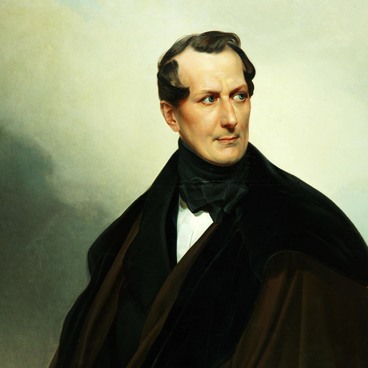Carl Johann Lasch, a German painter, was born in Leipzig in 1822. He obtained artistic education in Dresden Academy of Arts, continuing his education in Munich and Rome after. In 1847, he arrived to Moscow and lived there for about ten years, becoming a trendy portraitist over that time. His popularity and credibility were so high that Petersburg Academy of Arts bestowed an honorable title of a prodigal partner. Despite his wide acknowledgement in both Russia and Europe during his lifetime, the artist is not widely known by today.
The considerable amount of paintings that are in many collections in different cities of Russia indicate that Lasch worked a whole lot. This portrait from Rybinsk Museum’s collection was painted in 1856. It was contributed to the museum from the collection of counts Musin’s-Pushkin’s. The model’s resemblance to the heroine of two other works of the same collection suggests that the woman depicted is Countess Lyubov Musin-Pushkin. She was the wife of Alexey Musin-Pushkin, who was a marshal of the court, a leader of nobility in the Petersburg District, and a trustee of several gymnasiums and lyceums.
Musin-Pushkin is depicted waist-deep, her figure turned left, with her head partially turned to other side, revealing the sight of her big gray eyes. Her dark parted hair is smoothly combed and halfway covers her ears. Her hair is decorated with a hairpin connected to black opaque fabric with pink roses. The same roses are depicted on the corsage of her maroon velvet dress, which reveals her bare shoulders. The short velvet sleeves of the dress are extended by more black opaque fabric. The excessively generalized scenery with storm clouds on a bluish-gray sky serves as a background.
Even though Lasch is more famous for his portraiture, he also did genre paintings after his return to Europe. German critique was loyal to these: the professionals complimented the painter for his strong coloring and smart choice of subjects. In 1869, William I, the German Emperor, bestowed a title of painting professor upon Lasch. Three years later, the Berlin Academy of Arts awarded him a large golden medal. Lasch died in 1888, while visiting his relatives in Moscow.
The considerable amount of paintings that are in many collections in different cities of Russia indicate that Lasch worked a whole lot. This portrait from Rybinsk Museum’s collection was painted in 1856. It was contributed to the museum from the collection of counts Musin’s-Pushkin’s. The model’s resemblance to the heroine of two other works of the same collection suggests that the woman depicted is Countess Lyubov Musin-Pushkin. She was the wife of Alexey Musin-Pushkin, who was a marshal of the court, a leader of nobility in the Petersburg District, and a trustee of several gymnasiums and lyceums.
Musin-Pushkin is depicted waist-deep, her figure turned left, with her head partially turned to other side, revealing the sight of her big gray eyes. Her dark parted hair is smoothly combed and halfway covers her ears. Her hair is decorated with a hairpin connected to black opaque fabric with pink roses. The same roses are depicted on the corsage of her maroon velvet dress, which reveals her bare shoulders. The short velvet sleeves of the dress are extended by more black opaque fabric. The excessively generalized scenery with storm clouds on a bluish-gray sky serves as a background.
Even though Lasch is more famous for his portraiture, he also did genre paintings after his return to Europe. German critique was loyal to these: the professionals complimented the painter for his strong coloring and smart choice of subjects. In 1869, William I, the German Emperor, bestowed a title of painting professor upon Lasch. Three years later, the Berlin Academy of Arts awarded him a large golden medal. Lasch died in 1888, while visiting his relatives in Moscow.

